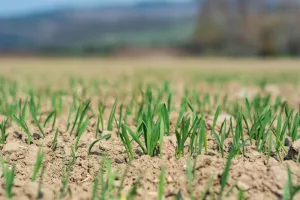NestApple Guide to the Best Grass Seed for Sandy Soil (2025)
Go Back To Previous PageThe grasses that thrive in sandy soil include tall fescue, zoysia, Bermuda grass, Bahia grass, and centipede grass. If you’re aiming to grow a healthy lawn in sandy soil conditions, here’s what you need to know. While trees and various plants can flourish in both sandy soil and clay soil, grass typically struggles.
This is mainly because sandy soil contains loose particles that create air pockets. As a result, water drains quickly from the soil, making it difficult for it to retain nutrients. Additionally, the loose structure of the soil can hinder the roots from establishing a solid foundation.
What is sandy soil like?
Sandy soil has large particles and a loose, gritty texture similar to that of beach sand. It has several distinct features that differentiate it from other soil types:
- Excellent Drainage: Sandy soil allows water to drain quickly, whether from rainfall or irrigation. This can have both advantages and disadvantages. On the plus side, it prevents plants from sitting in waterlogged soil. However, it also means that nutrients can be washed away rapidly.
- Low Nutrient Content: Sandy soil is generally less fertile because of its larger particle size, which contributes to the loss of organic matter, air, and water. To support healthy plant growth, you will likely need to fertilize regularly or create your compost.
- Rapid Warming: The light texture and low moisture content of sandy soil enable it to warm up quickly in the spring. This helps plants grow faster and develop deeper root systems.
- Ease of Handling: Thanks to its loose structure, sandy soil is easy to till and work with, making it an ideal choice for various gardening and landscaping projects.
- Good Aeration**: The large spaces between the particles in sandy soil allow for excellent aeration. This promotes healthy root development and reduces soil compaction.
1. Zoysia Grass
The best grass for sandy soil is Zoysia grass because of its long, strong root system, which enables it to withstand high heat and drought conditions effectively. Once established, Zoysia grass quickly spreads to form a lush, dense turf that is highly resistant to foot traffic.
This warm-season grass thrives when planted in late spring or early summer. It goes dormant during the winter, turning golden brown before rejuvenating in the warmer months.
Zoysia grass is also adaptable to poor, dry soil conditions, as its extensive root system enables it to absorb nutrients efficiently. The most challenging aspect of growing Zoysia grass is ensuring that it is adequately established. Once it takes root, it grows rapidly and remains healthy for an extended period.
While Zoysia grass prefers frequent sunlight, some varieties also adapt well to shady areas.
areas.
2. Tall Fescue
Tall fescue is a perennial, cool-season grass that is ideal for sandy yards in the northern parts of the United States. This highly adaptable grass can thrive in a wide range of draining soil conditions.
Although it grows slowly, tall fescue is relatively low-maintenance. It performs well in both sunlight and shade, with its prime growing seasons occurring in spring and fall.
Tall fescue boasts a deep root system, which makes it resistant to drought and enables it to retain water effectively. Red fescue and hard fescue are the best varieties for sandy soil, as they can quickly fill in empty or patchy areas of a lawn. Most types of fescue grass prefer a soil pH between 5.5 and 8.0, enabling them to grow in a wide range of soil conditions.
3. Bermuda Grass
Bermuda grass is an excellent choice for sandy soil. This warm-season grass thrives in well-drained environments with lower water content. While it takes some time to establish, Bermuda grass grows quickly and spreads to form a dense turf.
Bermuda grass requires ample sunlight to flourish; it does not perform well in shady areas with limited direct sunlight. This type is drought-resistant and enters a dormant state during winter, but it revives in spring and summer. Two popular varieties are Riviera Bermuda and Yukon Bermuda, both known for their good drought and cold resistance, making them suitable for transition zones.
Bermuda grass grows well in both sandy and clay soils. Its deep rhizome root system effectively absorbs nutrients. However, a key drawback is its need for constant sunlight; without it, the grass will struggle to thrive.
4. Centipede Grass
Centipede grass is extremely low-maintenance and requires minimal watering, making it an ideal choice for sandy soils. This type is a warm-season grass that thrives in the spring and summer. Additionally, centipede grass is highly resistant to heat, making it well-suited for warmer regions of the country, such as Florida, particularly in the central and northern areas where sandy soil is prevalent.
However, it is essential to note that centipede grass has a relatively shallow root system compared to other warm-season grasses.
5. Bahia Grass
Bahia grass is a perennial warm-season grass that thrives in sandy soil. It features a deep root system, which provides high heat and drought tolerance, making it well-suited for a variety of soil conditions. Additionally, Bahia grass requires minimal maintenance and little water, making it an excellent choice for sandy areas. However, one drawback of Bahia grass is that it does not produce the densest lawn.
Tips to Grow Grass in Sandy Soil
Many species of grass struggle to grow well in sandy soil. One of the main challenges with sandy soil is its loose texture, which makes it difficult for grass roots to establish and penetrate. Additionally, sandy soil drains quickly and does not retain nutrients as effectively as other types of soil.
Grasses that require ample moisture and nutrients often struggle to thrive in such conditions. Therefore, to successfully grow grass in sandy soil, it’s advisable to first enhance the soil’s nutrient quality through the use of fertilizers and soil amendments.
How Do I Treat My Lawn in Sandy Soil?
One of the primary challenges with sandy soil is that it does not retain nutrients as effectively as other types of soil, making it more challenging to grow a healthy lawn. Sandy soil has large particles that allow water to drain, and its loose composition makes it hard for roots to take hold.
One way to treat sandy soil is to add a compost layer to help grass form a dense thatch layer that will keep it anchored to the ground. You can also add fertilizers that are high in nitrogen and potassium, two nutrients that grass and plants need to grow healthily.
One thing to watch out for with sandy soil is salt levels. Salt can stay in the soil, and the sodium content can damage plants and grass. Plant-based composts such as peat are a good way to amend the soil composition while minimizing salt levels.
Best Grass Seed For Sandy Soil Bottom Line
Growing grass in sandy soil is not difficult if you select the correct type of grass seed. When choosing the best grass seed for sandy soil, consider your location’s specific climate. With the proper selection, you can achieve a healthy, green lawn.
Additionally, the more grass you grow, the better the soil quality will become. Established grass layers contribute to thatch, which helps the soil retain moisture and nutrients. Therefore, sandy soil tends to work better for reseeding an existing lawn rather than starting a new one from scratch.


